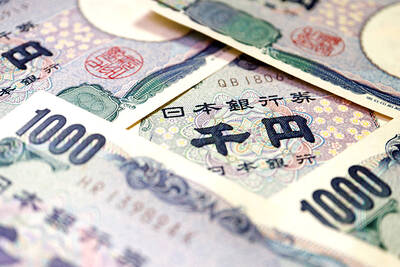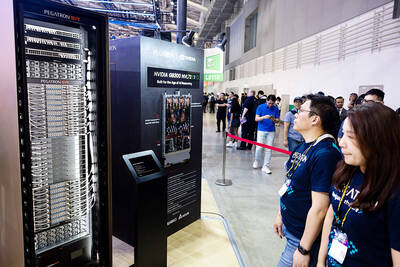Line Pay’s electronic payment services (EPS) reported NT$556.5 million (US$18.1 million) in transfers between accounts in September, ranking first and accounting for 86.3 percent of total transfers made via mobile payment tools in Taiwan, Financial Supervisory Commission (FSC) data showed.
In the month, total transfers between electronic payment accounts held by different entities registered at the 26 active electronic payment providers jumped 673 percent to NT$644.82 million from NT$83.4 million in August, data released on Thursday last week showed.
Third-party payment providers are still not allowed to offer transfer services, nor are they allowed to transfer funds using electronic stored-value cards, as the government regulates such activity, because of money-laundering concerns, the commission said.
Fund transfers were largely neglected by major players until Line Pay in September promoted its services by awarding users with digital red envelopes.
“The transfer function is becoming really popular,” an FSC official surnamed Chen (陳) said on Thursday.
Although not the core business of electronic payment service providers, transfer functions can spare people from having to travel to the bank or using card readers to transfer money online, Chen said, adding that they are convenient when, for instance, splitting the bill at a restaurant.
Some local companies have even used the function to pay bonuses to their employees, Chen said.
Line launched combined electronic payment and stored-value card services on Sept. 3, and by the end of the month registered Line Pay/iPass accounts reached 517,593 users, ranking it fourth in electronic payment services after E.Sun Commercial Bank (玉山銀行), with 795,414 users, AllPay Financial Information Service Co Ltd (歐付寶), with 760,308 users and Jkos Pay (街口), with 539,897 users, FSC data showed.
Line Pay is popular because it makes it easy for users younger than 20 to register for electronic payments and charges no fees for peer-to-peer transfers, Wanning Liao (廖婉寧), a communications officer at LINE Biz+ Taiwan Ltd, the operator of Line Pay, said on Friday.
However, use of Line Pay as an in-store payment tool remained low in September, totaling NT$8 million in transactions and accounting for just 0.3 percent of the NT$2.53 billion in electronic payments in the month, FSC data showed.
Line Pay is expanding partnerships with stores nationwide and expects to see the number rise, Liao said.
Line Pay had more than 3.7 million registered users in Taiwan at the end of September, of which 13.99 percent had a Line Pay/iPass electronic payment account, the company said, adding that there is ample room for further growth.

AI TALENT: No financial details were released about the deal, in which top Groq executives, including its CEO, would join Nvidia to help advance the technology Nvidia Corp has agreed to a licensing deal with artificial intelligence (AI) start-up Groq, furthering its investments in companies connected to the AI boom and gaining the right to add a new type of technology to its products. The world’s largest publicly traded company has paid for the right to use Groq’s technology and is to integrate its chip design into future products. Some of the start-up’s executives are leaving to join Nvidia to help with that effort, the companies said. Groq would continue as an independent company with a new chief executive, it said on Wednesday in a post on its Web

RESPONSE: The Japanese Ministry of Finance might have to intervene in the currency markets should the yen keep weakening toward the 160 level against the US dollar Japan’s chief currency official yesterday sent a warning on recent foreign exchange moves, after the yen weakened against the US dollar following Friday last week’s Bank of Japan (BOJ) decision. “We’re seeing one-directional, sudden moves especially after last week’s monetary policy meeting, so I’m deeply concerned,” Japanese Vice Finance Minister for International Affairs Atsushi Mimura told reporters. “We’d like to take appropriate responses against excessive moves.” The central bank on Friday raised its benchmark interest rate to the highest in 30 years, but Bank of Japan Governor Kazuo Ueda chose to keep his options open rather than bolster the yen,

Even as the US is embarked on a bitter rivalry with China over the deployment of artificial intelligence (AI), Chinese technology is quietly making inroads into the US market. Despite considerable geopolitical tensions, Chinese open-source AI models are winning over a growing number of programmers and companies in the US. These are different from the closed generative AI models that have become household names — ChatGPT-maker OpenAI or Google’s Gemini — whose inner workings are fiercely protected. In contrast, “open” models offered by many Chinese rivals, from Alibaba (阿里巴巴) to DeepSeek (深度求索), allow programmers to customize parts of the software to suit their

Global server shipments are expected to surge to 15 million units next year, from 4 million units this year, with artificial intelligence (AI) servers accounting for about 30 percent, driven by massive capital spending by major cloud service providers, the Market Intelligence and Consulting Institute (MIC) said on Thursday last week. Major cloud service providers — including Google’s parent company Alphabet Inc, Microsoft Corp, Amazon.com Inc and Meta Platforms Inc — are projected to budget US$450 million for capital expenditure next year, up from US$400 million this year, MIC ICT [information and communications technology] Industry Research Center director Edward Lin